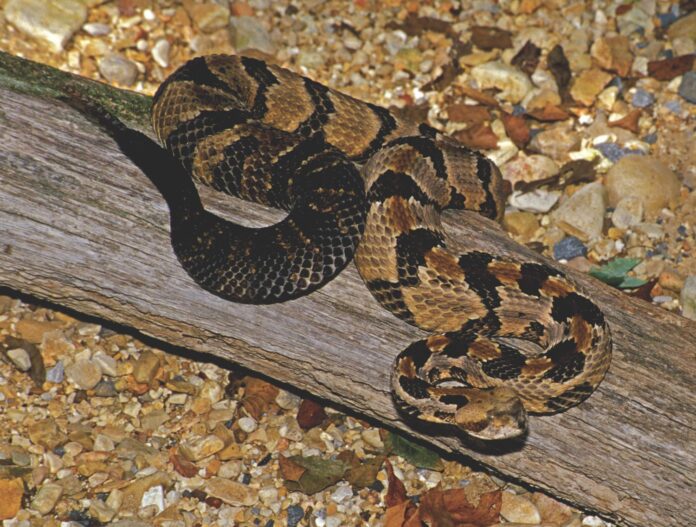
AUBURN UNIVERSITY, Ala. – Summertime is in full throttle, and outdoor enthusiasts are being extra cautious because of snakes. Most native Alabama snake species are not venomous. However, there are several toxic species that you need to be able to identify.
Venomous snakes in Alabama
According to the Alabama Department of Conservation and Natural Resources (ADCNR), Alabama is home to six venomous snake species. A bite from any of them is considered a medical emergency, and a victim must immediately seek treatment.
“Although snakebites are a serious issue around the world, only about five people die each year in the United States after an encounter with a venomous snake,” said Wesley Anderson, an Alabama Cooperative Extension System forestry, wildlife and natural resources specialist.
Snake identification
Most of the state’s 44 snake species are harmless. The most important tool to safety is the skill to identify the snakes in your area.
“Always use multiple characteristics whenever identifying a snake,” Anderson said. “Nonvenomous snakes will often act in ways that mimic venomous snakes.”
For example, many harmless snakes will flatten their heads. Just because a snake has a triangular head, doesn’t mean its venomous. Also, many nonvenomous snakes–along with copperheads and cottonmouths–will shake their tails when frightened. In this case, if you are solely using sound as a factor, this faux movement could lead you to believe you’re in the presence of a rattlesnake. There are also existing color variations and mutations among snake species. So, always use multiple defining characteristics to be more confident in your decision.
To brush up on your venomous snake identification skills, review the list below.
Copperhead
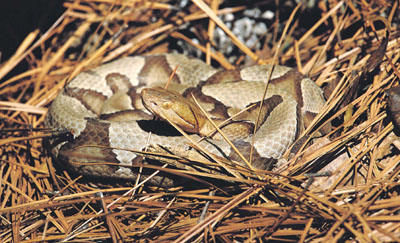
Copperheads are the most common venomous snake throughout Alabama and the primary culprit of reported snakebites. Like cottonmouths and rattlesnakes, they are vipers. More specifically, they are pit vipers and use their heat-sensing pits on their head to see under low-light situations.
Their name is derived from the copper color of their heads. They aren’t large snakes, with most measuring 2 to 3 feet long. Aside from the copper head, another characteristic to look for are their unique bands. The dark bands have smooth lines along the edges. From the side, they’re compared to a Hershey’s Kiss candy. From the top, they look like an hourglass. Young copperheads will also have chartreuse-colored tails.
Cottonmouth
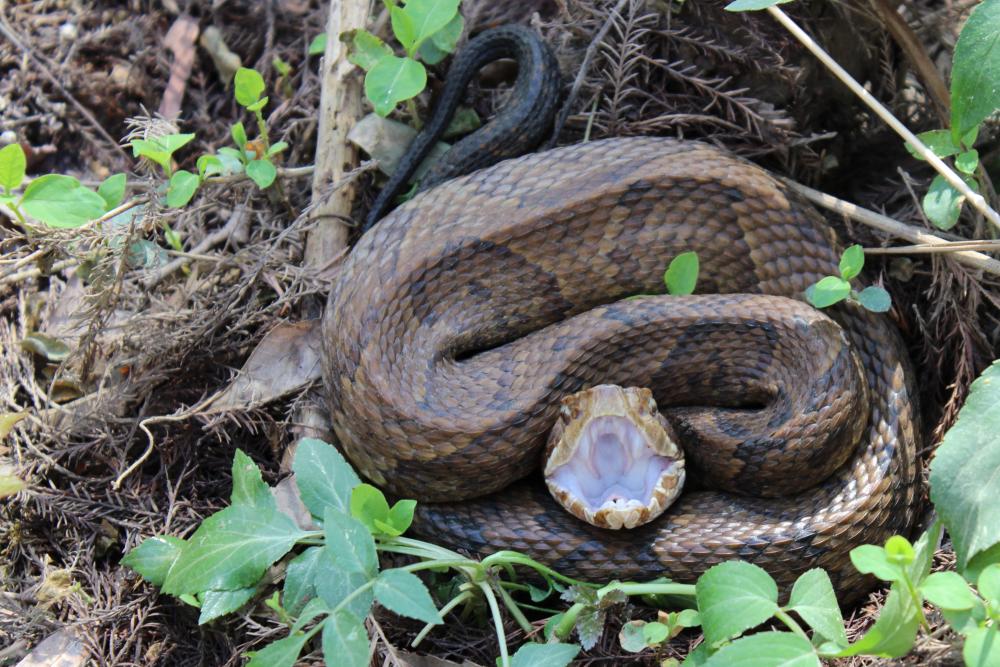
Cottonmouths are a more aquatic relative to the copperhead. The terms cottonmouth and water moccasin for this species are synonymous. They are common but tend to be found less frequently than copperheads since they are primarily near water sources.
Cottonmouths are named for their behavior to gape and expose their light, white mouth lining as a warning when threatened. Adults tend to be larger than their copperhead cousins. An average adult measures between 2 and 4 feet. They have a similar banded pattern; however, the edges of the bands tend to have a ragged or pixelated appearance. This pattern is often lost or obscured as they get older.
This banding cannot be relied upon as the sole identifying characteristic. Cottonmouths also have a dark mask that extends from the back of the jaw to the eye. Also, like copperheads, the young will have a chartreuse tail.
“Cottonmouths are frequently confused with water snakes,” Anderson said. “One good way to tell them apart is by looking at the mouth. Water snakes have dark vertical bars on their lip scales; cottonmouths do not. Cottonmouths also have blocky heads with a sharp angle from the top of the head to the front of the face, preventing someone from seeing their eyes if looking at them from above.”
Pygmy rattlesnake
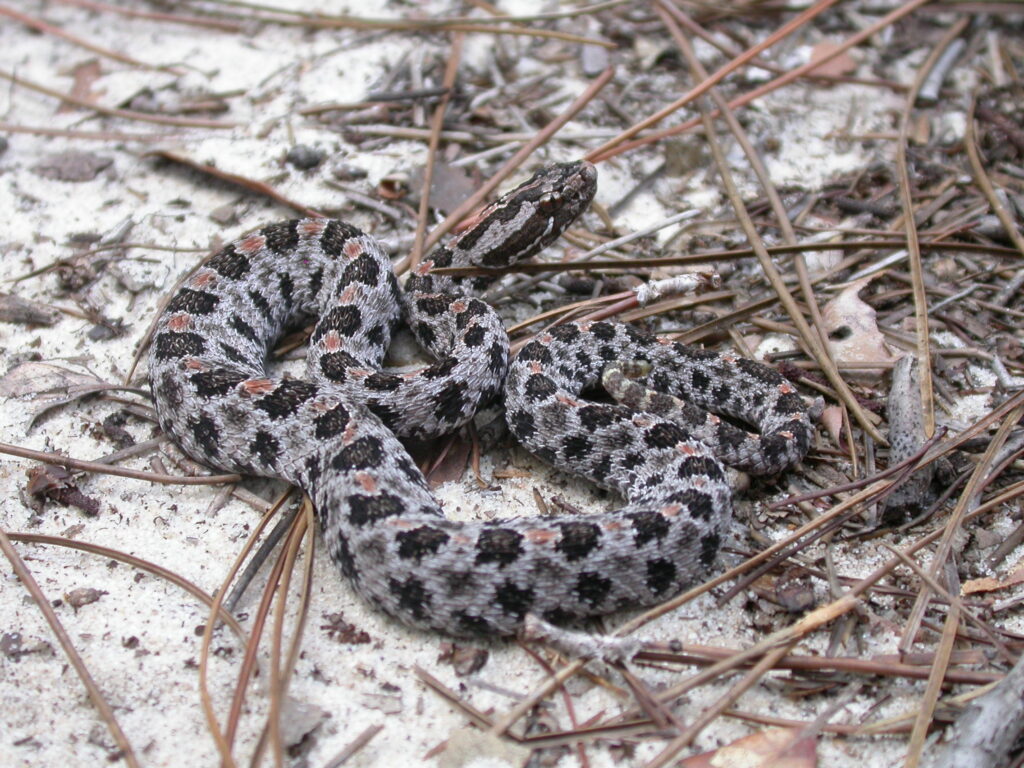
Pygmy rattlesnakes are Alabama’s smallest species of rattlesnake. Adults only grow one to one-and-a-half feet long. This species is also known as ground rattlers. They do have a rattle; however, it is so small that it often sounds more like a buzzing insect than a rattlesnake. Identifiers of pygmy rattlesnakes are blotches on both their back and sides and a potential reddish-brown stripe down the spine.
Timber rattlesnake
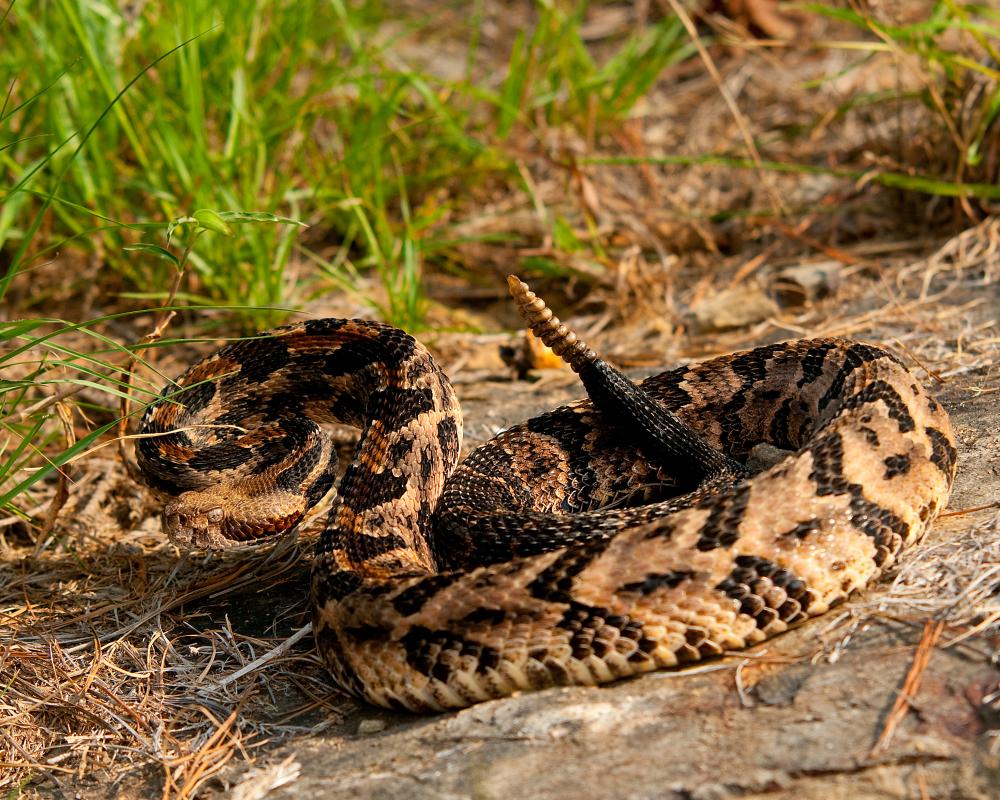
Timber rattlesnakes are medium-to-large rattlesnakes found throughout much of the state. Average adults measure 3 to 5 feet in length. They can measure up to 6 feet, but that is exceedingly rare.
Their solid black tail is a diagnostic characteristic for this species. Another characteristic to look for are the chevron markings extending down the middle of their back. Base color varies from light gray to brown. A rusty colored dorsal stripe is sometimes present.
Eastern diamondback rattlesnake
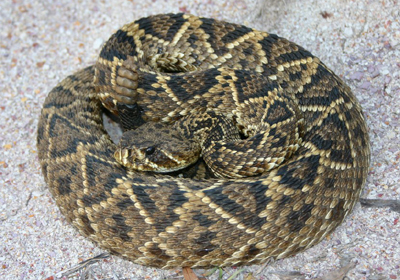
The Eastern diamondback rattlesnake is Alabama’s largest species of venomous snake. Adults average 4 to 6 feet long but can reach nearly 8 feet in length. They are easily identified by the diamond pattern on their back that runs the length of their body. The diamondback and timber rattlesnake can both be found in the southern part of the state, but diamondbacks tend to be in drier, more upland areas – especially longleaf pine forests.
Eastern coral snake
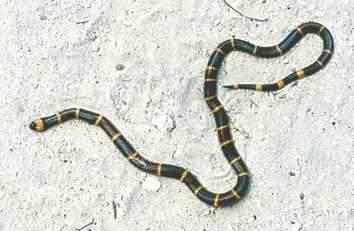
In Alabama, Eastern coral snakes are the only snake in the elapid family. This is a group of snakes that include cobras and mambas. Their tricolored (i.e., red, yellow and black) pattern makes them easy to distinguish.
However, there are two nonvenomous snakes – the scarlet snake and scarlet kingsnake – that mimic this species. For the Eastern coral snake, the red bands touch yellow bands. For the coral snakes’ counterparts, red bands touch black bands. Many people have heard the rhyme to differentiate the two, but Anderson no longer encourages teaching it.
“There are a couple reasons for the change in the coral snake rhyme,” Anderson said. “There have been documented cases of people misremembering the rhyme and being bitten by coral snakes. The other reason is that abnormal coral snakes exist that might, for example, have dark, bordering on black, red bands.”
Coral snakes have a short, blunt head that starts with a black band. The other species will have longer heads starting with a red band. If there is any doubt, do not handle any tricolor snake. The Eastern coral snake averages 20 to 30 inches in length but can reach nearly 4 feet. They also possess a potent neurotoxic venom that can result in paralysis and asphyxiation. It is a myth that coral snakes need to chew to inject venom. Remember, they are cousins to cobras.
More information
Remember, it is vital that any venomous snake bite be considered a medical emergency. For the scoop on serpents in Alabama, contact your local Extension agent or specialist to learn about which species are in your area. Also, visit the Alabama Extension website at www.aces.edu to learn more about Alabama’s snake species.





























